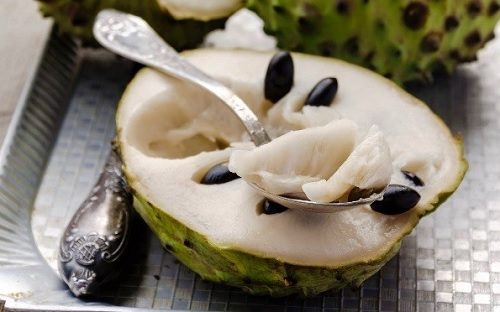9 Benefits of Eating Sugar-Apples

The sugar-apple is a heart-shaped fruit native to the Peruvian Andes. Its flesh is sweet, contains seeds, and is covered by a green skin. Sugar-apples are harvested in winter and fall, just like oranges and grapefruit. And, most important of all, sugar-apples are really healthy.
They’re rich in vitamins (A, B complex and C), as well as minerals (potassium, calcium, magnesium, iron, and zinc). The many benefits of eating sugar apples have been proven in this study by Dr. Sudhakar Kokate.
Today, we want to share with you some of the many benefits of eating sugar-apples. We’re sure that by the end of this article, we’ll have convinced you to start making them a regular part of your diet.
You might like: The 10 Healthiest Tropical Fruits
1. Sugar-apples improve cardiovascular health

Thanks to its high potassium content, sugar-apples help contribute to better cardiac health, as suggested in this study conducted by the Las Condes Clinic, Chile. Furthermore, they also act as a natural blood pressure regulator. Plus, sugar-apples are rich in antioxidants, which help to control cholesterol levels.
Additionally, its low sodium and fat content is another reason to eat this fruit, especially for people who suffer from high blood pressure and other cardiac problems.
2. A natural anti-microbial
Another benefit of eating sugar-apples is their ability to act as natural protection against parasites, as shown in this study conducted by the National University of Agriculture of La Selva, Peru. These properties are due to its high content of fiber, niacin, and cytotoxins. Additionally, it contains high quantities of vitamin C, a natural antioxidant that helps the body fight infections.
3. They are a great weight-loss ally
Eating sugar-apples makes you feel fuller, which is ideal if you’re trying to lose weight without cutting out healthy, delicious foods. You can add it to your diet as a snack, dessert or as a post-workout meal.
You might like: Try These Healthy Weekly Weight Loss Menus
4. They have a calming effect
Sugar-apples can help regulate the nervous system, according to information from the Mexican Ministry of Agricultural and Rural Development. That means they work kind of like a tranquilizer, making them a great home remedy for people who suffer from stress or anxiety.
5. Protection against osteoporosis
This fruit contains a high level of minerals, which function as adjuvants in the recovery processes of several different diseases.
- They contain iron, which aids in the recovery of people suffering from anemia.
- They’re rich in calcium, which helps those suffering from bone disorders and osteoporosis.
- Sugar-apples are also rich in phosphorus, which helps to improve memory.
6. They can improve your pregnancy

Eating sugar-apples is a good idea for future mothers. Apart from being delicious, they have a high nutritional value, according to food technologist, pharmacist and nutritionist María del Carmen Moreu. Sugar-apples contain nutrients that aid in the healthy development of the baby, including:
- Essential fats
- Fiber
- Carbohydrates
- Proteins
- Minerals
- Vitamins
7. They help regulate digestion
According to del Carmen Moreu, eating sugar-apples is good for those who feel weak, or who have spent several days in hospital. It’s also good for those who have trouble digesting certain foods, or suffer from indigestion.
Moreover, its low fat content and high fiber content help to both eliminate bad cholesterol (LDL) and, at the same time, absorb bile acids. This is very useful for people who suffer from gallbladder conditions.
In addition, it’s also an excellent natural laxative, given that its fiber regulates intestinal transit and bacterial flora.
8. Sugar-apples contain high levels of antioxidants
Sugar-apples are an excellent source of antioxidants and vitamin C, as confirmed in this investigation carried out by the National Institute of Agricultural Sciences (Cuba).
9. They are an excellent food for small children

Because of their high nutritional content, pediatricians highly recommend including sugar-apples in purees or juices to help promote development in children. Plus, as we’ve already mentioned, they also taste great.
Parts of the sugar-apple and their benefits
The pulp of the sugar-apple isn’t the only bit you can use – other parts of the fruit are also thought to have interesting properties. Many believe that the various parts of the fruit have the following benefits:
- Skin: when cooked, it serves as a home treatment for chronic colitis.
- Seeds: can be used as a treatment for dandruff, and even as an anti-emetic.
- Roots: an infusion of the roots serves as a strong purgative.
- Leaves: when used as a tea, they help to calm spasms and cramps. This is also a home remedy for anemia, colitis, and malnutrition.
- Ripe fruit: Can be eaten in chunks or prepared as a puree. It helps to treat malnutrition, anemia, and weakness.
However, there is insufficient evidence to confirm the supposed benefits associated with the different parts of the sugar-apple.
Now that you know the benefits of eating sugar-apples, you can start to incorporate them into your diet. However, just remember not to overdo it. Despite their many benefits, they’re also high in sugar, so it’s best not to eat more than one serving per day and to avoid eating them every day of the week.
All cited sources were thoroughly reviewed by our team to ensure their quality, reliability, currency, and validity. The bibliography of this article was considered reliable and of academic or scientific accuracy.
- Correa-Gordillo, J., Ortiz, J., Sa´nchez-Mejı´a, M., & Pacho´n, H. (2012). Antioxidant activity in guanabana (Annona muricata L.): a literature review. Latin American and Caribbean Bulletin of Medicinal and Aromatic Plants.
- González, M. E. (2013). Chirimoya (Annona cherimola Miller), frutal tropical y sub-tropical de valores promisorios. Cultivos Tropicales. https://doi.org/ISSN 0258-5936
- Ramalingum, N., & Mahomoodally, M. F. (2014). The therapeutic potential of medicinal foods. Advances in Pharmacological Sciences. https://doi.org/10.1155/2014/354264
- Sanjinés Asturizaga, A., Øllgaard, B., & Balslev, H. (2006). Frutos comestibles. In Botánica Económica de los Andes Centrales. https://doi.org/10.1142/S1363919618500020
This text is provided for informational purposes only and does not replace consultation with a professional. If in doubt, consult your specialist.








